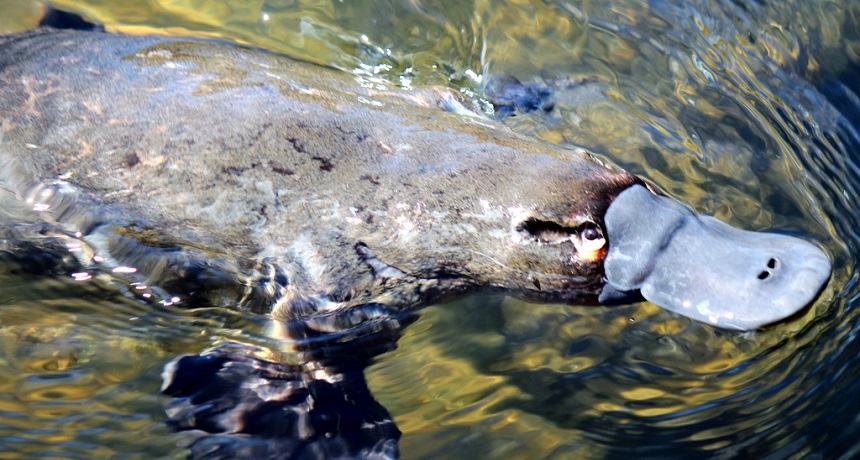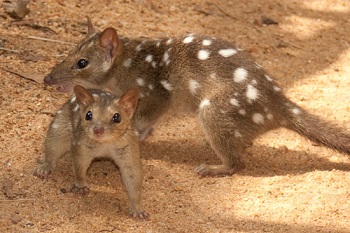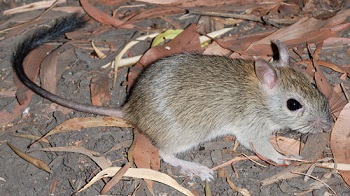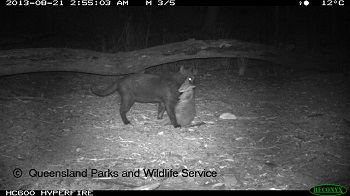Cats and foxes are eating up Australia’s mammals
Continent’s animals prove surprisingly vulnerable to non-native species

The platypus is threatened by a number of factors. One threat is its becoming the lunch of cats and foxes.
Trevira1/Flickr (CC-BY-NC 2.0)
People first settled Australia some 40,000 to 50,000 years ago. Then, in 1788, England established a colony there. These European settlers spread widely. In time, they created the nation of Australia. The European immigration also led to a little-noticed wave in extinctions of Australian mammals. That’s the finding of a new study. One main cause of those extinctions appears to be the introduction of foxes and feral cats, the study concludes.
Worldwide, at least 84 mammal species have gone extinct since the 1500s. The new study finds that four out of every 10 of those extinct mammals had called Australia home. Every 10 years since the 1840s, the continent has lost one or two of its mammals.
The loss of Australian mammals went “largely unnoticed until recently,” says John Woinarski. He is a conservation biologist at Charles Darwin University in Darwin, Australia. He also led the new study, which appears February 9 in the Proceedings of the National Academy of Sciences. There are “a few conspicuous exceptions,” he says — such as the thylacine, also known as the Tasmanian tiger. But, he notes, “most of the now extinct mammals were inconspicuous, shy, nocturnal, small and lived remote from most human population centers.”

Seven once-common species that disappeared from Australia still survive on neighboring islands. And neither cats nor foxes have ever lived on these islands.
Consider also the size of Australia’s disappearing mammals. Elsewhere in the world, large mammals have been the ones most likely to go extinct. But in Australia, vulnerable animals have weighed a mere 35 grams to 5.5 kilograms (1.2 ounces to 12 pounds). That’s the perfect size meal for a cat or fox.
Woinarski points to several more reasons that Australia’s mammals have been vulnerable. Scientists refer to members of the cat family as felids (FEE-lidz). Members of the dog family are canids (KAY-nidz). “Almost all other continents have a wide range of native felid and canid species,” he observes. So animals in these places had “some ‘pre-adaptation’ to predators such as cats and foxes,” he notes. But Australia’s ecosystems evolved without cats. Dingos, a canid species, have lived on the continent only for some 4,000 years.
Many Australian mammals also have few young. So any losses to predators can make it difficult for their populations to recover. And introduced herbivores, such as cattle and sheep, have reduced plant cover in many places. That has left native mammals with fewer places to hide.

In it, Tim Doherty of Edith Cowan University in Joondalup, Australia, and his colleagues scoured reports of what Australia’s feral cats had been eating. Many animals prefer to eat only one or a few species. Some cannot or would not stray beyond their preferred foods. But not cats, this study found.
They preferred to eat rabbit. In some ways that’s good. The reason: On this continent, rabbits have themselves proven a devastating invasive species. That means their deaths should pose no problem to ecosystems there. But when the cats couldn’t find rabbits, they turned to some other species. And nearly any other smallish species was fair game. Doherty’s team turned up 400 different species of vertebrate animals that they devoured.
His team’s findings appear in the February 2 Journal of Biogeography.
Beyond cats and dogs
Other factors also have contributed to big losses of Australia’s mammals, Woinarski’s team finds. For instance, European settlements brought pollution and habitat destruction. And human activities around the globe have been driving climate change, which has led to a warming and drying of Australia.
In one unusual case, an introduced species actually harms the native animals that eat it. Cane toads are native to South America. Since their deliberate introduction in 1935, the toads have spread across the northern reaches of Australia. The bad news for local animals: These toads are toxic. When native mammals, such as the northern quoll, eat them, they can be poisoned.
Then there is an infectious cancer that is killing off Tasmanian devils. These mammals are small, aggressive marsupials.

Power Words
(for more about Power Words, click here)
cancer Any of more than 100 different diseases, each characterized by the rapid, uncontrolled growth of abnormal cells. The development and growth of cancers, also known as malignancies, can lead to tumors, pain and death.
canid The biological family of mammals that are carnivores and omnivores. The family includes dogs, wolves, foxes, jackals and coyotes.
climate change Long-term, significant change in the climate of Earth. It can happen naturally or in response to human activities, including the burning of fossil fuels and clearing of forests.
conservation The act of preserving or protecting the natural environment.
conservation biologist A scientist who investigates strategies for helping preserve ecosystems and especially species that are in danger of extinction.
drought An extended period of abnormally low rainfall; a shortage of water resulting from this.
extinct An adjective that describes a species for which there are no living members.
felid The family of cat species. It includes not only house cats but also the big species, such as lions, tigers, ocelots and jaguars.
feral Animals that were once domesticated but now run wild. Examples may include feral dogs, horses or pigs.
habitat The area or natural environment in which an animal or plant normally lives, such as a desert, coral reef or freshwater lake. A habitat can be home to thousands of different species.
herbivore A creature that either exclusively or primarily eats plants.
invasive species (also known as aliens) A species that is found living, and often thriving, in an ecosystem other than the one in which it evolved. Some invasive species were deliberately introduced to an environment, such as a prized flower, tree or shrub. Some entered an environment unintentionally, such as a fungus whose spores traveled between continents on the winds. Still others may have escaped from a controlled environment, such as an aquarium or laboratory, and begun growing in the wild. What all of these so-called invasives have in common is that their populations are becoming established in a new environment, often in the absence of natural factors that would control their spread. Invasive species can be plants, animals or disease-causing pathogens. Many have the potential to cause harm to wildlife, people or to a region’s economy.
mammal A warm-blooded animal distinguished by the possession of hair or fur, the secretion of milk by females for feeding the young, and (typically) the bearing of live young.
marsupials Mammals that carry their young for a period after birth in external pouches where the developing babies will have access to their mother’s nipples — and milk. Most of these species evolved in Australian and have especially long hind-legs. Examples of marsupials include kargaroos, opossums and koalas.
native Associated with a particular location; native plants and animals have been found in a particular location since recorded history began. These species also tend to have developed within a region, occurring there naturally (not because they were planted or moved there by people). Most are particularly well adapted to their environment.
nocturnal An adjective for something that is done, occurring or active at night.
population A group of individuals from the same species that lives in the same area.
predator (adjective: predatory) A creature that preys on other animals for most or all of its food.
quoll A small, meat-eating marsupial that has a spotted coat and looks similar to a cat. These animals are native to Australia and New Guinea.
species A group of similar organisms capable of producing offspring that can survive and reproduce.
thylacine Also known as the Tasmanian tiger, it was once the world’s largest marsupial. But overhunting wiped this predator species out. The last wild member of this species was shot in 1930. The last captive thylacine died six years later.
toxic Poisonous or able to harm or kill cells, tissues or whole organisms. The measure of risk posed by such a poison is its toxicity.
vertebrate The group of animals with a brain, two eyes, and a stiff nerve cord or backbone running down the back. This group includes all fish, amphibians, reptiles, birds, and mammals.







